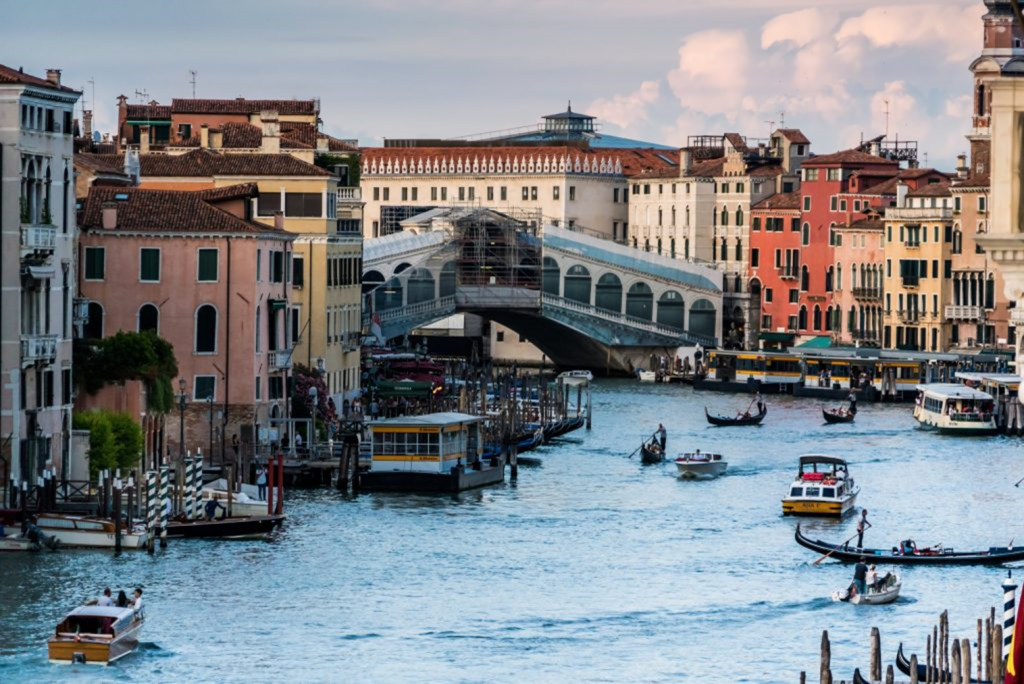Beautiful places of Venice. Today Venice is perceived as a component of the creative and engineering patrimony of all humankind, a fitting job for a city whose thousand-year financial and political autonomy was supported by its part in worldwide exchanging. The circumstance of the city on islands has restricted current rural spread past the notable place; its structure of waterways and limited roads has forestalled the interruption of the vehicles.
Here we have prepared a list of beautiful places for you to visit in Venice, so don’t miss the chance.
1) Canal Grande

The Grand Canal not just interfaces a large portion of Venice’s top vacation destinations, it is one of its top attractions. Bending in a converse S through the core of the city, it is likewise Venice’s Main Street, consistently occupied with traffic that incorporates everything from gondolas to barges conveying produce to showcase.
The most ideal way of seeing and like this load of fantastic royal residences is from the actual trench, as their exteriors face the water. Reviewing these royal residences after the lights happen in their sparkling insides is one of the most loved activities in Venice around evening time.
2) Santa Maria die Miracoli

After the tremendous loftiness of St. Imprint’s and the taking-off region of Frari, little Santa Maria dei Miracoli resembles a new breeze, a show-stopper of Early Renaissance design by Pietro Lombardo. This gem box of pastel trimmed marble was worked from 1481 to 1489 to revere a marvelous image of the Virgin.
Dissimilar to Venice’s other places of worship, whose exteriors are decorated with design twists and sculptures, Lombardo utilized meticulously coordinated with shaded marble to make sensitive examples of octagons, rosettes, crosses, and circles on the veneer. The strategy proceeds inside, which increases the impact of the brilliant domed roof transcending dark and coral marble dividers.
The nave is isolated from the chancel by an impeccable Early Renaissance balustrade improved with figures. It’s no big surprise that this is Venetians’ cherished spot to be hitched, as its inside is one of the most excellent in the city.
3) Scuola Grande di San Rocco

This amazing white marble building was worked somewhere in the range of 1515 and 1560 to house a beneficent society committed to San Rocco. Before long it’s finishing, the extraordinary sixteenth-century Venetian craftsman Tintoretto won the opposition to paint a focal board for the roof of the Sala dell’Albergo by entering the structure and placing his artwork in its expected spot before the judging, no doubt arousing a lot of bothering for his opponent specialists.
The lighting isn’t acceptable, and the artistic creations themselves are dim, yet you can in any case like Tintoretto’s advancements in the utilization of light and shading. You can see the roofs all the more effectively with one of the mirrors that are given. More works by Tintoretto are in the chancel of the contiguous church of San Rocco.
4) Murano and Burano

An outing to Venice wouldn’t be finished without jumping on board a Vaporetto for the ride across the tidal pond to Murano, home of Venice’s mythical glass laborers. They were sent here in the thirteenth century in anticipation of diminishing the danger of fire from one of the glass heaters moving throughout Venice’s firmly compacted focus.
The trench sides today are lined by glass display areas and studios, showing everything from modest imported knickknacks to perfect show-stoppers. Inside the seventeenth century, Palazzo Giustinian is the Glass Museum, with one of the biggest and most significant assortments of Venetian glass from the hour of the Romans to the twentieth century.
In any case, it’s not all glass: The congregation of Santi Maria e Donato joins Veneto-Byzantine and Early Romanesque elements, a consequence of its different phases of working between the seventh and twelfth hundreds of years. Notice particularly the segments of Greek marble with Veneto-Byzantine capitals, the twelfth-century mosaic floor with creature figures, and the St. Donato over the main special stepped area on the left. Dated 1310, it is the most punctual illustration of Venetian composition.
5) Palazzo Rezzonico

Palazzo Rezzonico gives a clear image of life here in the Baroque and Rococo time frames, in the eighteenth century. Planned and started by Venice’s lord of Baroque design, Baldassare Longhena, the royal residence was finished almost 100 years after the fact in 1750 by Giorgio Massari.
The goods and assortments complete the image painted by the structure, including its inside beautification of silk divider covers, exquisite completion subtleties, and Flemish woven artworks. The outfit assortment features the significance of silk creation in Venice from the late medieval times through the eighteenth century when it was a significant contender with Lyon, France.
Unbending specialized guidelines were authorized, bringing about the absolute most lovely silk textures at any point made. So significant was silk that even in the midst of a battle with the Turks, fight lines separated for the silk-loaded boats to go through.
The gallery subtleties the significance of extravagance products, especially attire and style, for the Venetian economy in the eighteenth century, when brocades decorated with gold and silver string created here were loved all through Europe and the New World.

